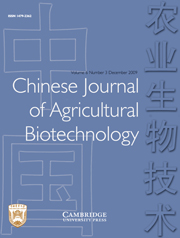Article contents
Immuno-capture PCR method for detecting Acidovorax avenae subsp. citrulli from watermelon
Published online by Cambridge University Press: 02 August 2007
Abstract
An immuno-capture polymerase chain reaction (IC-PCR) method for detection of Acidovorax avenae subsp. citrulli (AAC), the causal organism of bacterial fruit blotch (BFB) of watermelon, was developed by combining the immunosorbent enrichment (ISE) method with classical PCR and comparing with the direct PCR and growth check methods. The results showed that all A. avenae subsp. citrulli strains tested have produced 360 bp specific fragments using IC-PCR and direct PCR methods, while other strains from 10 different genera showed negative PCR results. The minimum detection concentration was about 50–100 cfu/ml and 104 cfu/ml, respectively. The IC-PCR sensitivity was 100 times higher than that of direct PCR. The examination of seven batches of different melon seeds from the markets by IC-PCR showed that one cantaloupe, two honeydew melon and two watermelon seed varieties carried the pathogen, indicating that the IC-PCR is an accurate, sensitive, rapid and low-cost technique.
- Type
- Research Article
- Information
- Copyright
- Copyright © China Agricultural University and Cambridge University Press 2007
Footnotes
First published in Journal of Agricultural Biotechnology 2006, 14(6): 946–951
References
- 8
- Cited by


